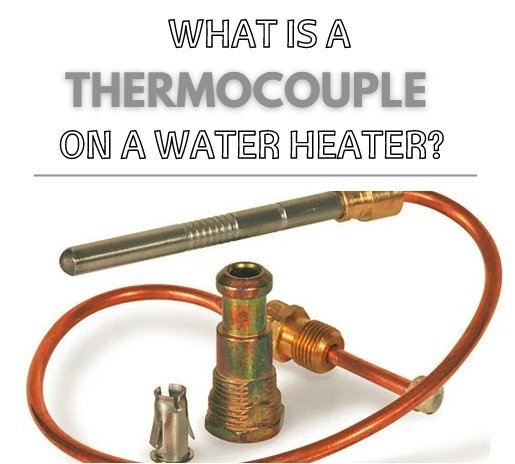Understanding the role of a thermocouple in your water heater is essential for proper maintenance and care, especially when it comes to ensuring the safety of your home’s gas supply. Having worked on various types of water heaters over the years, I have seen first-hand how a faulty thermocouple can compromise the safety and efficiency of the system.
This small but crucial component prevents common problems and ensures your water heater operates safely and efficiently.
The water heater is one of the most crucial devices at home, delivering comfort and convenience. But then, you want a safe device. You want to ensure it’s completely safe and trusted, and this is when the thermocouple functions.
The Function of a Thermocouple
Basically, the thermocouple is the one preventing the device from becoming dangerous. You see, the thermocouple is a safety component with a simple design. It’s made from two strips of metal types joined within one end. The thermocouple is usually near the pilot light, near the burner assembly.
Read also: Dangers of Tankless Water Heaters and the Possible Problems

When there is something wrong with the pilot light, the thermocouple will close the gas line off automatically. During a recent service call, I encountered a gas water heater where the pilot light frequently went out. Upon inspection, it was clear that the thermocouple had become corroded, preventing it from sensing the flame.
Replacing the thermocouple immediately resolved the issue, underscoring its critical role in gas safety. Its main responsibility is to prevent the combustion from being flooded with unburned gas. With the thermocouple, you won’t have to worry about the possibility of an explosion.
Let’s not forget that not all heaters have thermocouples. The thermocouple is commonly found on gas heaters. Electric heaters don’t have thermocouples because they don’t use gas. Some heaters use the so-called mercury sensor as the replacement for the thermocouple.
Read also: How to Replace Thermocouple On Water Heater
Not all thermocouples would be surely functional most of the time. Some of these gas water heater thermocouples aren’t 100% perfect, as there is always a possibility of defect, damage, or fault. According to industry experts, common indicators of a faulty thermocouple include a pilot light that won’t stay lit or visible damage, such as cracks on the thermocouple tube.
A study highlights that this component’s regular maintenance and timely replacement can prevent 90% of gas-related accidents in water heaters.
How Do You Know If Your Thermocouple Is Bad?
Now that you know what a thermocouple on a water heater is and its function, you can check for signs of failure or fault. If it’s the culprit, then you should be able to see obvious defect signs.
- Tube contamination. If you see pinholes, cracks, or discoloration on the thermocouple’s jacket, you likely have a problematic thermocouple.
- Missing wiring insulation. When there is a tear on the thermocouple’s insulation wiring, it will create bad insulation that doesn’t work at all. You may want to perform further checks on the wiring thoroughly.
- Connector faulty. The connector is crucial because it connects to the temperature transmitter. When the connector is loose, the thermocouple won’t function properly.
| Signs of a Faulty Thermocouple | Recommended Action |
|---|---|
| Pilot light won’t stay lit | Replace the thermocouple immediately |
| Cracks or discoloration on the tube | Inspect and replace the thermocouple |
| Loose connector | Tighten the connector or replace the thermocouple |
| Weak pilot flame (orange/yellow) | Check for obstructions in the pilot tube |
What Happens When a Thermocouple Goes Bad?
The thermocouple’s primary role is to keep the pilot light lit, ensuring the gas control valve functions correctly. When the pilot light doesn’t stay lit, it’s often a sign of a faulty thermocouple. This situation requires immediate attention, as it involves the thermocouple’s ability to regulate the gas supply and prevent unburned gas from accumulating.
Based on years of fieldwork, it is crucial to understand that while a bad thermocouple is often the cause of a pilot light going out, other factors, such as drafts or dirt in the burner assembly, can also contribute. This is why a comprehensive inspection is recommended before replacing parts.
So, when the pilot light doesn’t light, you can suspect your thermocouple is the culprit. If the pilot light doesn’t light completely, it is probably not the entire fault of the thermocouple.
The procedure requires you to light the flame and hold the gas valve manually (while allowing the thermocouple to heat up). So, it’s highly likely not the thermocouple’s fault when the pilot doesn’t light up despite your efforts, and you are 100% sure that the gas is already on. There is always a possibility that the pilot tube is being obstructed.
Read also: Temperature Sensor Failure Water Heater
However, your thermocouple is likely the culprit when the flame lights up but then goes out when releasing the gas control (after you hold it).
You should also take a look at the pilot flame. If it has an orange and yellowish tinge and seems small, it’s too weak to heat the thermocouple. If this is the case, it’s not the thermocouple but the pilot tube’s obstruction.
What to Do?
You can always check the device on your own or hire a professional service to do the work for you. If you have zero knowledge and experience, it’s wise to turn to professionals. Let them do the heavy lifting while you sit back and wait for the result.
Now that you have understood the basic facts to the question of what a thermocouple on a water heater is, you have the true options.


